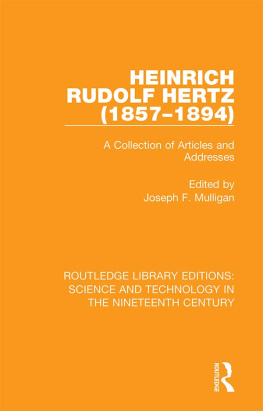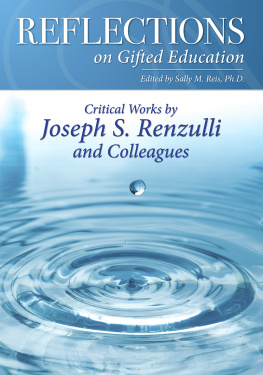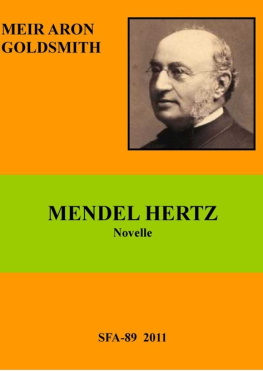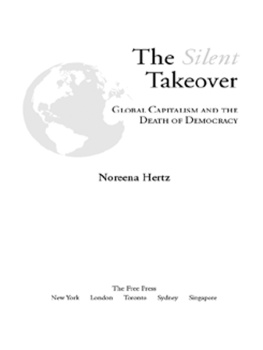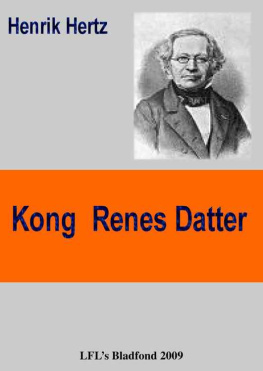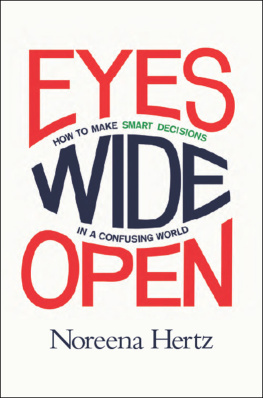ROUTLEDGE LIBRARY EDITIONS: SCIENCE AND TECHNOLOGY IN THE NINETEENTH CENTURY
Volume 6
HEINRICH RUDOLF HERTZ
(18571894)
HEINRICH RUDOLF HERTZ (18571894)
A Collection of Articles and Addresses
Edited by
JOSEPH F. MULLIGAN
First published in 1994 by Garland Publishing, Inc.
This edition first published in 2019
by Routledge
2 Park Square, Milton Park, Abingdon, Oxon OX14 4RN
and by Routledge
52 Vanderbilt Avenue, New York, NY 10017
Routledge is an imprint of the Taylor & Francis Group, an informa business
1994 Joseph F. Mulligan
All rights reserved. No part of this book may be reprinted or reproduced or utilised in any form or by any electronic, mechanical, or other means, now known or hereafter invented, including photocopying and recording, or in any information storage or retrieval system, without permission in writing from the publishers.
Trademark notice: Product or corporate names may be trademarks or registered trademarks, and are used only for identification and explanation without intent to infringe.
British Library Cataloguing in Publication Data
A catalogue record for this book is available from the British Library
ISBN: 978-1-138-39006-5 (Set)
ISBN: 978-0-429-02175-6 (Set) (ebk)
ISBN: 978-0-367-07493-7 (Volume 6) (hbk)
ISBN: 978-0-429-02102-2 (Volume 6) (ebk)
Publishers Note
The publisher has gone to great lengths to ensure the quality of this reprint but points out that some imperfections in the original copies may be apparent.
Disclaimer
The publisher has made every effort to trace copyright holders and would welcome correspondence from those they have been unable to trace.
Gravestone of Heinrich Hertz in the cemetery of Hamburg-Ohlsdorf. Photograph by Helmut Drubba, Hannover, Germany; courtesy of Mr. Drubba and Dr. James G. OHara, Leibniz-Archiv, Hannover.
HEINRICH RUDOLF HERTZ
(18571894)
A Collection of Articles and Addresses
Edited by
Joseph F. Mulligan
1994 Joseph F. Mulligan
All rights reserved
Library of Congress Cataloging-in-Publication Data
Hertz, Heinrich, 18571894.
Heinrich Rudolf Hertz (18571894): a collection of articles and addresses/edited by Joseph F. Mulligan.
p. cm. (Garland reference library of the humanities; vol. 1697)
Includes bibliographical references and index.
ISBN 0-8153-1288-1 (alk. paper)
1. PhysicsHistory. 2. ElectromagnetismHistory. 3. Hertz, Heinrich, 18571894Biography. 4. PhysicistsGermanyBiography. I. Mulligan, Joseph F. (Joseph Francis), 1920 . II. Title.
III. Series.
QC7.5.H47 1993
537dc20
93-34637
CIP
Printed on acid-free, 250-year-life paper
Manufactured in the United States of America
This book is dedicated
to the memory of
Heinrich Rudolf Hertz (18571894)
on the occasion of
the 100th anniversary
of his death
Contents
An account, by Hertzs assistant at Bonn, which contains interesting material on Hertzs early life. The quotations from Hertzs letters provide revealing insights into Hertzs character and outlook.
This eloquent tribute to Helmholtz, prepared for the celebration of Helmholtzs seventieth birthday in 1891, reveals Hertzs lifelong gratitude and devotion to his mentor, colleague, and friend.
An important theoretical paper in which Hertz derives Maxwells equations by a novel, ingenious procedure. This leads him to assert the superiority of Maxwells theory over all competing theories of electromagnetism.
FitzGeralds review provides a good summary of Hertzs more important early papers and, despite some probing criticism, reveals his admiration for Hertzs research accomplishments and those of his mentor, Helmholtz.
An Introductory Overview that summarizes both the experimental and theoretical components of Hertzs electromagnetic research at Karlsruhe. He concludes that his experiments have confirmed the fundamental tenets of the Faraday-Maxwell theory.
A description of the techniques Hertz employed to produce and detect electromagnetic waves with wavelengths of about six meters. Resonance effects turned out to be of great importance and were used in his subsequent experiments on electromagnetism.
The first paper ever published on the photoelectric effect. In it Hertz shows conclusively that ultraviolet light increases the electric discharge from ordinary metals. In an amazingly thorough series of experiments he then discusses the effect on the discharge of changing the metals, the light sources, and the intervening medium.
Hertz describes his success in producing standing electromagnetic waves and in measuring their wavelengths. He suggests that such waves may be identical with light waves and considers that his observations provide further evidence for Maxwells theory.
This is the most impressive of all Hertzs experimental papers on electromagnetism. He demonstrates conclusively that electromagnetic waves of 66-cm wavelength can be formed into a beam by a parabolic cylindrical reflector and can be reflected, refracted, polarized, and made to interfere. Electromagnetic waves may therefore be properly called beams of light of very great wavelength.

